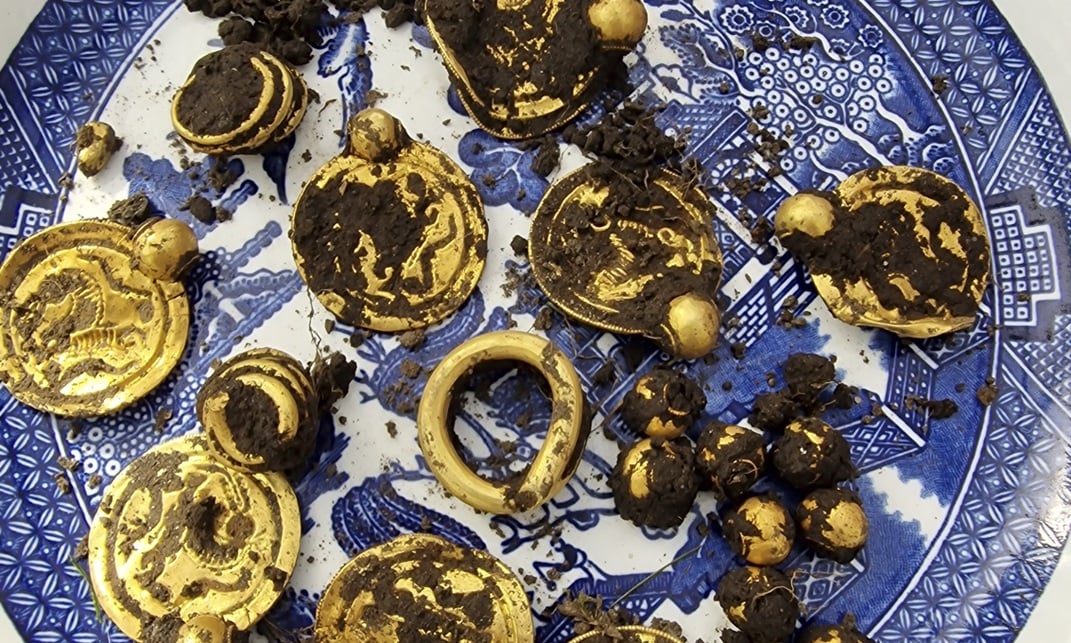
Last summer, an amateur metal detectorist in Norway discovered what archaeologists have hailed as Norway’s “gold find of the century”.
He dug up nine engraved gold pendants, ten gold pearls, and three gold rings—all dating to the sixth century A.D. on the island of Rennesøy.
Erlend Bore initially thought he’d unearthed some old chocolate coins; in reality, he’d struck gold. Officials say the discovery is the first of its kind in the country since the 1800s.
“This is the gold find of the century in Norway,” says Ole Madsen, director of the Museum of Archaeology at the University of Stavanger, in a statement. “To find so much gold at the same time is extremely unusual.”
A Norwegian man, Erlend Bore, was told by his doctor to get more exercise daily. This prompted him to buy a metal detector.
Few days ago, Sept 7th, his device began beeping on a hillside, and this was when he made a remarkable discovery: a stack of gold coins.
Norwegian… pic.twitter.com/6r7T3DfksX
— Archeology and History (@archehistory) September 9, 2023
Bore, 51, made the discovery over the summer. One day, after searching with little success, he decided to change his strategy, as he tells the Norwegian Broadcasting Corporation (NRK). He looked out over the landscape and thought, “If this was a long time ago, where would I have been?”
Bore moved to higher ground. There, his metal detector began to beep. “I was suddenly sitting with a gold treasure in my hands,” he tells the NRK. Soon after, he sent a photo of the find to nearby experts.
Related: Long-Lost Ship Found in the Desert Laden With Gold
Gold find: Hidden valuables or offerings to the gods?
The pendants and beads likely once made up “an exceptionally splendid necklace,” says Håkon Reiersen, an archaeologist at the museum, in the statement. The jewelry may have been “crafted by skilled goldsmiths and worn by the most powerful individuals in society.”
Dating to 500 A.D., the artifacts come from a particularly difficult time in history. “This period likely marked a crisis with crop failures, worsening climate and plagues,” says Reiersen. “The numerous abandoned farms in Rogaland from this era suggest that the crisis hit this region particularly hard.”
Based on the location and historical context, Reiersen thinks the artifacts “were most likely either hidden valuables or offerings to the gods during that dramatic time.”
The pendants are also noteworthy for their depictions of horses. Similar pendants from this period often feature images of the Norse god Odin healing sick horses, and they were worn to bring protection and good health, as Sigmund Oehrl, another archaeologist at the Museum of Archaeology, says in the statement.
While Odin doesn’t appear on the newly discovered pendants, Oehrl thinks they carried a similar meaning.
“On these gold pendants, the horse’s tongue hangs out, and its slumped posture and twisted legs suggest that it is injured,” says Oehrl.
“Similar to the Christian symbol of the cross, which was spreading in the Roman Empire at the same time, the horse symbol represented illness and hardship, but also hope for healing and new life.”
Norwegian law dictates that objects older than 1537—and coins older than 1650—become state property. Conservators at the Museum of Archaeology are now cleaning the artifacts, which they hope to put on public display.
Bore will, however, receive a finder’s fee, and he plans to continue his new hobby. As he tells the NRK, “I haven’t found a silver coin.”
Related: 1400-Year-Old Gold Foil Figures Discovered in Pagan Temple in Norway
See all the latest news from Greece and the world at Greekreporter.com. Contact our newsroom to report an update or send your story, photos and videos. Follow GR on Google News and subscribe here to our daily email!



